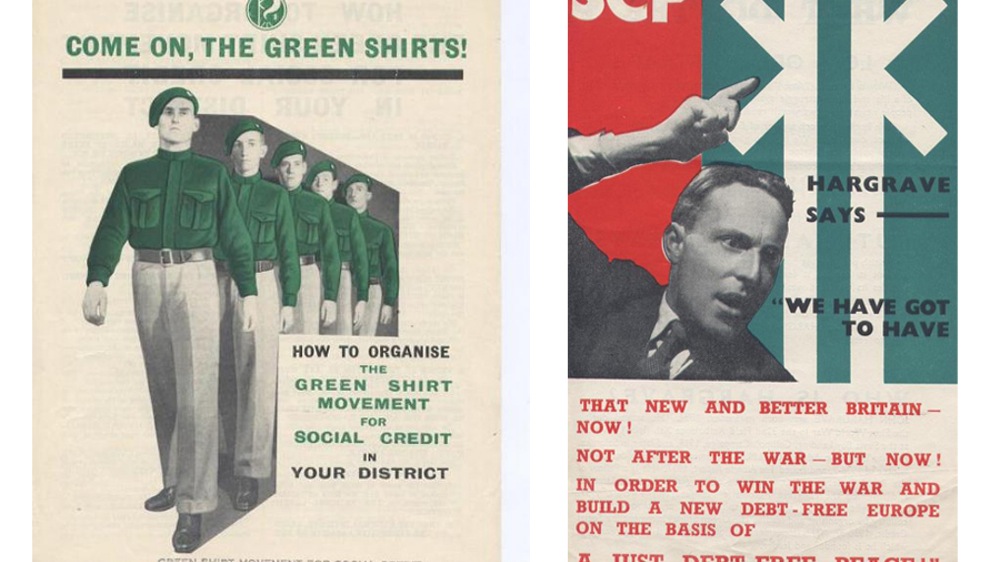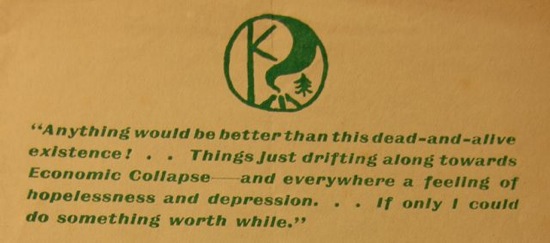England’s Dreaming: John Hargrave & The Occult Roots Of Universal Income Pt.2

Part 1 of the story of Johnn Hargrave's strange career in politics and magic is over here
Having created the Kibbo Kift to salve the psychological scars of a country recovering from the horrors of World War I, Hargrave found himself growing frustrated. Despite his best efforts, society stubbornly refused to elevate towards the utopia that sparkled at the end of his rhetorical rainbows. He had identified a problem that hasn’t been much alleviated to this day; whilst he believed that the combination of woodcraft skills, comradeship, ritual and play were essential to repairing the spiritual torpor of industrialised society, the only people capable of indulging in these past times were those of independent means. Essentially the Kibbo Kift were a group of wealthy people pissing about in the forest. Unlike the majority of his Kibbo Kift acolytes, Hargrave came from a poverty stricken background and had relied on his wits to keep him from the daily industrial grind. His income was bolstered when he began a new career as a writer; in 1924 he wrote Harbottle, the first of several best-selling novels that easily raised enough cash to support his bohemian existence. He was aware that this was a blessed position that few others enjoyed. [As a side note, of the books he did put out his, 1931 sci-fi story The Imitation Man looks particularly interesting. It tells of an inventor who creates an android with telepathic powers – these powers unthinkingly link human minds to create a collective global hive mind. “One is uncertain,” reviewed the Spectator, “whether the life story of this passionless laboratory-made man is intended as a satire on our mechanical age or is an exercise in highly original ingenuity.]

Hargrave’s solution to the long standing problem that only the rich had the leisure to embrace the Kibbo Kift came sometime around 1923, when he first met Major Clifford Hughes Douglas. Douglas was a British engineer who was convinced- fairly presciently it would seem- that machines would eventually replace human labour. Rather than despair, Douglas proposed a solution; Social Credit. The major tenant of Social Credit was the paying of a regular national dividend to all citizens, regardless of status, thus to improve basic spending power and reduce the reliance on credit, which would have a desired knock on effect of reducing the power of the banks. Douglas’s ultimate aim was the creation of a Leisure State where “the compulsion to work merely in order to live decently simply did not exist”. Everything in this philosophy laid the groundwork for what modern thinkers are calling universal income – and Hargrave was utterly sold on this radical response to a straitened world. As the 20s rolled on, Hargrave became increasingly interested in embedding the idea of social credit into society, and to this end he sought to turn the Kibbo Kift into his own political movement.
Schisms inevitably followed – although this was as much down to Hargrave’s brook-no-argument authoritarian leadership style as his newfound commitment to radical politics. In 1925 a socialist leaning Kibbo Kift group was set up in South London called BrockleyThing – Hargrave refused to recognise the group for reasons that are dispute; the BrockleyThing leader Lesley Paul claimed the group weren’t recognised because Hargrave was becoming increasingly right wing (although this seems unlikely given Hargrave’s increasing interest in socialist ideas), whilst Hargrave’s people claimed he wouldn’t recognise this new group because their existence was a direct challenge to his authority as leader. Either way, Paul’s splinter group eventually evolved into the Woodcraft Folk, a far more successful back-to-nature youth movement that retains members to this day.
Meanwhile Hargrave started expanding his sphere of influence in earnest, determined to create a social movement of genuine power. Historian Josef Craven describes this period of change:
“By 1928 Hargrave was speaking in terms of a new direction for the Kibbo Kift. It could no longer remain a small elite, deliberately and purposefully 251 tucked away in preparation for the 'Day of Action.' It was now time to open the doors and bring in as many new members as possible to swell the ranks of the Kindred. The Kin was now approaching the end of its 'Formative Period' according to Hargrave. 'Focus', 'Uniformity' and 'Obligation' had been the watchwords up to this stage of the Kibbo Kift's development, but now they must "Expand! Open Up! Take In!" Hargrave noted that "[they] ha[d] stressed the idea of 'obligation' to such an extent that today, it would seem as if one had to be fully fledged Nietzschean Superman before one could be admitted as a Kinsman. This is absurd and defeats our purpose." [from http://discovery.ucl.ac.uk/1348858/1/327041.pdf]
Hargrave’s first move was to create a series of coalitions with unemployed workers (or, as he termed them, ‘the new leisured classes’), starting first with towns in the North of England where work was scarce and dissatisfaction rife. He formed the Northern Surplus Labour Group in Gateshead, followed by a Kibbo Kift Homing Pigeon Club- an attempt to appeal to the culture of unemployed miners. As former high ranking Kibbo Kift members fall away, disappointed at Hargrave’s perceived lack of interest in the country pursuits that had originally defined the group, he threw his lot in with a Coventry based group called ‘The Legion of the Unemployed’, established in 1930 by a jobless mechanic named George Hickling. Hargrave saw the power of Hickling’s growing group of angry underclass, and pressed upon the League the power of adopting a uniform and a strong name. Taming the more esoteric, mythological elements of design he had utilised in the Kibbo Kift, in 1931 Hargrave came up with the Greenshirts uniform – a militaristic look for Britain’s first social movement dedicated to implementing universal basic income.
At first the Kibbo Kift and the Greenshirts ran concurrently, and Hargrave saw his numbers swell far beyond the handful of hundred who had originally followed his back-to-the-land ideology. Riding the crest of a wave, Hargrave hired a London office and turned his attention to propaganda, producing a Green Shirts newsletter called ‘Attack’, strong on sloganeering and bold graphics – here are some examples I’ve managed to dig up from antiquarian magazine stockists –

With the sheer level of material Hargrave pumped out, along with the increasing memebership the Greenshirts attracted, it’s remarkable that they have been largely forgotten – especially when they were pulling in numbers comparable to Oswald Mosely’s notorious fascist group, the British Union of Fascists (aka the Blackshirts). It's not as if the Greenshirts were particularly polite compred to their political peers.Hargrave constantly had an eye for attention grabbing antics, and the group could soon be seen regularly marching the streets and agitating for change, kicking off against far left and far right groups alike – as the Kibbo Kift foundation write,



“The Greenshirts own vendetta was with neither the political Left or Right who they regarded as 'two rats caught in a trap'. The target of Hargrave's highly professional propaganda was 'the rat-catcher'.”
“'The Bankers' otherwise referred to as 'the Money Power' or 'the Forces of Finance Capital', were accused of perpetuating and profiting from an iniquitous 'monopoly of credit' to the ruination of employer and worker alike. Despite a Total War on the Banking System declared and ruthlessly waged by Hargrave, and despite a then current and popular identification of Bankers with the Jews, it is pleasing to report that there is not a trace of anti- semitism to be found in Greenshirt propaganda; while in his writing, Hargrave himself goes out of his way to praise the Jews and their immeasurable contribution to civilisation.”
By the mid-30s, the Greenshirts were marching in their thousands. Hargrave wasn’t shy of using outrageous publicity stunts to spread the name of the Greenshirts, and there are conflicting reports that a ‘green clad’ protestor either hurled a green painted brick through the window of 11 Downing Street (the chancellors residence) or shot a green arrow into its door – the latter image seems fairly probable, Hargrave would be more than aware of the power of linking his popular movement to the powerful folk memory of Robin Hood.
With a growing membership, and sympathetic ears across the country, it’s entirely possible that the Greenshirts might have come closer to realising their aims had they not been crippled by the Public Order Act of 1936 forbidding the wearing of political uniforms. This has been remembered as a response to the spread of Blackshirt fascism – but the knowledge that the Greenshirts had a high membership and wider appeal than Moseley’s hard right group makes the Act seem somewhat less benign. Was it powered – at least in some part – by a desire to shut down appeals for Social Credit? A far more thorough historian than me is going to have to take that one on.
With the uniforms taken away, the movement faltered, before completely dying out when World War II started up. After that war Hargrave tried to resurrect the movement, but the time had passed. He had an attempt to run as MP for Stoke Newington on a social credit ticket, only picked up 550 votes and lost his deposit. This was to all intents and purposes the final blow for Britain’s first social credit movement, and Hargrave spent the rest of his life as a writer, designer, paert time inventor, and, in later years, a spiritual healer.
But looking back on the years thet Greenshirts gained traction, there are lessons to be learned. Hargrave actively mobilised the unemployed and under employed, starting outside of London to create a power base before trying to make his voice heard in the capital. He was open in his use of propaganda, and understood the power of bold design in capturing the imagination. Right now, with UKIP trying their best to steal Labour seats in the North of England, it feels like an image heavy, slogan heavy movement dedicated to worker’s rights (without the mis-direction of immigrant fear mongering) could have equal impact. Where the charismatic leader who can run it all will come from remains anyone's guess…






















